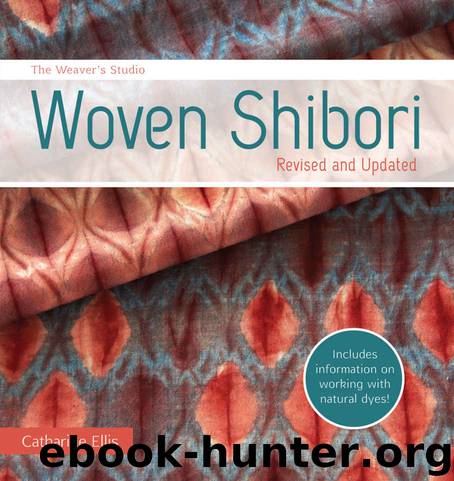The Weaver's Studio - Woven Shibori: Revised and Updated by Catharine Ellis

Author:Catharine Ellis [Ellis, Catharine]
Language: eng
Format: epub
Publisher: F+W Media
Published: 2016-06-23T22:00:00+00:00
Working with Supplemental Warps
The main benefit of warp shibori for the weaver is that only one shuttle is needed instead of the two required in weft shibori, making the weaving process more efficient. The use of a single shuttle makes it easier to keep track of complex ground structures or fiber changes. Another benefit of using supplemental warps is the efficiency of gathering the pattern threads. Woven fabrics are usually longer than they are wide. This means you will place and pull more threads and make many more knots in weft shibori. For example, consider a length of fabric four yards long by one yard wide (366 × 91.5 cm); there would be four times as many supplemental wefts as there would be supplemental warps in the same piece.
An important difference between the two approaches is that supplemental warps create horizontal pleats, while the pleats made from supplemental wefts are vertical. This will affect the orientation of the dyed resist and thus the design of the cloth.
When weaving with supplemental warps, there are two warps to consider: the ground warp and the supplemental warp. They take up differently, and there will be tension differences between them. It’s best to use two different warp beams. If two beams are not available, you can weight the supplemental threads, since there are so few of them relative to the ground warp. Shorter warps may be wound on the same beam as the ground, and the supplemental threads can be weighted as they loosen during the weaving.
Any of the drafts and weave structures I’ve referred to so far can be “turned” so that the threading and treadling reverse, and the pattern thread is in the warp instead of the weft. When threading the loom for supplemental warp weaving, shafts 1 and 2 are usually reserved for a plain-weave ground. Additional shafts are available for supplemental threads. The sett is determined for the ground weave. Pattern threads are placed only where needed in the warp, sharing space in the reed with the ground threads. To maintain the same balance of pattern to ground that has been used in weft shibori, there would be one warp thread for every four ground-warp threads.
The draft in Figure 1 shows supplemental warp threads in black while the ground weave is the gray and white. Each supplemental warp thread is raised above the cloth for several picks and then allowed to float underneath while the ground continuously weaves plain weave. The number of picks used while the pattern thread is raised or lowered determines the length of the float. Alternating the supplemental threads between shafts 3 and 4 in the threading will result in a textured pattern without any clearly defined pattern.
Download
This site does not store any files on its server. We only index and link to content provided by other sites. Please contact the content providers to delete copyright contents if any and email us, we'll remove relevant links or contents immediately.
On Writing A Memoir of the Craft by Stephen King(4863)
The Doodle Revolution by Sunni Brown(4685)
A Simplified Life by Emily Ley(4098)
Mummy Knew by Lisa James(3630)
Marijuana Grower's Handbook by Ed Rosenthal(3619)
Better Homes and Gardens New Cookbook by Better Homes & Gardens(3524)
Figure Drawing for Artists by Steve Huston(3381)
Paper Parties by Erin Hung(3369)
Draw Your Day by Samantha Dion Baker(3287)
The Genius of Japanese Carpentry by Azby Brown(3224)
Japanese Design by Patricia J. Graham(3109)
The Code Book by Simon Singh(3074)
Dangerous Girls by Haas Abigail(2976)
Lions and Lace by Meagan Mckinney(2922)
The Curated Closet by Anuschka Rees(2912)
How to Make Your Own Soap by Sally Hornsey(2826)
The Checklist Manifesto by Atul Gawande(2776)
The Wardrobe Wakeup by Lois Joy Johnson(2731)
Zero to Make by David Lang(2726)
